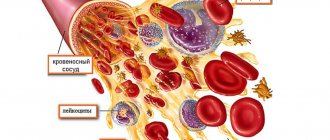Elevated blood sugar in men indicates various diseases of the internal organs - and most likely diabetes mellitus.
This is considered a “disease of a generation” among men whose age has exceeded their fifties: rarely does anyone follow such a healthy diet and lead an active lifestyle.
And, despite the prevalence of the disease (and according to the World Health Organization, 6% of the population suffers from it), one should not assume that it is so harmless. High and low blood sugar levels have their own serious consequences.
Symptoms and signs
Symptoms of high blood sugar vary among men. These differences depend on the type of diabetes the patient suffers from: first or second.
Type 1 affects 70,000 children worldwide each year and is considered juvenile diabetes. The second is more common: of all those susceptible to this disease, 90% are accounted for by it.
In the first, symptoms appear suddenly when pancreatic cells are destroyed against the background of infectious diseases or a severe decrease in immunity. Heredity plays an important role. In this case, people are dependent on insulin - with its deficiency, a diabetic coma develops in record time. Therefore, their lives depend on timely medications.
In type 2 diabetes, the pancreas turns out to be completely healthy, the amount of insulin it produces is normal - the concentration of sugar increases because the body is simply not able to absorb it. Signs may be mild, and the disease is not immediately diagnosed - which is why it is also called the “silent killer.”
One of the main reasons to see a doctor is obesity. Men are most often susceptible to apple-type obesity, when most of the excess weight accumulates in the abdominal area - this, in particular, is caused by metabolic characteristics and endocrine disorders due to an inactive lifestyle and overeating.
Obesity negatively affects all body systems
The main signs of high blood sugar in men are as follows:
- increased need to urinate;
- unquenchable thirst;
- apathy;
- increased appetite;
- drowsiness;
- irritability;
- itching;
- sudden weight loss (with the first type);
- obesity (with the second type);
- blurred vision;
- dry mouth;
- fungal skin infections;
- high blood pressure;
- long wound healing;
- diseases of the cardiovascular system;
- fatigue.
Persistent dry mouth and thirst are associated with frequent urination, which removes excessive amounts of water from the body.
Indigestion leads to a feeling of heaviness after eating, loose stools, and stomach pain. Despite this, appetite increases: the concentration of sugar in the blood is high, but the organs are not able to absorb it and experience constant starvation. Because of this, a man becomes apathetic, quickly gets tired even from small physical and mental stress, he develops shortness of breath and constantly falls asleep. The skin flakes and itches constantly. Normal blood sugar at 50 years old.
What is high blood sugar
Excessive dextrose content is a dangerous situation in which the concentration of a substance exceeds the norm. The main reasons for this change may be insulin-dependent or non-insulin-dependent diabetes mellitus, dysfunction of the endocrine system, problems with excess weight, alcoholism, and smoking. Without proper treatment, hyperglycemia will lead to ketoacidosis, microangiopathy, decreased immunity, and in particularly severe cases, hyperglycemic coma. According to statistical studies, endocrinologists were able to establish the normal range before and after eating foods:
| Pre-meal glucose concentration (mg/dL) | 120 minutes after dextrose loading | Cause |
| 59,4-99 | less than 140.4 | Norm |
| 99-109,8 | less than 140.4 | Glycemic disorders |
| 59,4-99 | 140,4-199,8 | Latent diabetes |
| 99-109,8 | 140,4-199,8 | Prediabetes |
| >109,8 | >199,8 | Diabetes |
Diabetes mellitus is the main disease associated with an increase in glucose due to low amounts of insulin. This dangerous disease may be acquired or hereditary. Diabetes is accompanied by a decrease in the ability to heal wounds, which can cause the formation of ulcers, and then trophic ulcers. In both type 1 and type 2 diabetes, hormonal medications are used, which, thanks to insulin, reduce the level of dextrose.
Reasons for the increase
The reasons for increased blood sugar in men can be both obvious and the most unexpected. The following diseases can be distinguished from them:
- Cushing's syndrome;
- pathology of the gastrointestinal tract;
- liver dysfunction;
- cardiovascular diseases.
Other causes of high blood glucose in men are associated with:
- bad habits;
- overweight;
- inactive lifestyle;
- improper treatment (drugs that disrupt metabolism);
- hereditary predisposition.
The list of reasons why blood sugar increases in men is long - therefore, if one of the listed factors, and especially if there are several of them at once, it is necessary to regularly examine the blood.
Stress
Normally, stress stimulates a man’s body’s defenses. The hormone cortisol, which is produced during psychophysical stress, promotes wound healing, increases performance, constricts blood vessels, and affects carbohydrate metabolism. When the hormone is released, insulin production decreases, the gastrointestinal tract is suppressed, and eating and sexual behavior changes. So the body reflexively inhibits the basal secretion of insulin and releases sugars from the depot. As a result, a hyperglycemic state and insulin deficiency develop. With chronic stress, tissue resistance to insulin decreases.
Nutritional Features
Nutrition for high blood sugar in men varies depending on weight, level of physical activity, and age, but there are a number of general rules that must be followed:
- eating at the same time every day;
- regular meals 5-6 times a day;
- food should be portioned - you should absolutely not overeat;
- remove foods rich in fast carbohydrates from your diet: pastries, chocolate, bananas and others.
Diabetic table No. 9 according to Pevzner is often prescribed, which helps get rid of excess blood sugar and lose weight. This diet has a reduced calorie content (2300 kcal), as the amount of food that contains fats or fast carbohydrates is reduced. Protein is retained in normal quantities. The consumption of foods rich in salt (interferes with the normal removal of fluid from tissues) and extractive substances is somewhat reduced with an increase in the consumption of dietary fiber and fiber. Food temperature unchanged.
Recommended Products
Distribution of substances in diabetic table No. 9:
- complex carbohydrates – 350 g;
- vegetable proteins – 45 g;
- animal proteins – 55 g;
- vegetable fat – 24 g;
- animal fat – 56 g;
- salt – 10 g;
- water – 1.5 l.
The patient needs to enrich his diet with vegetables in various forms (soups, baked or raw), fruits (excluding grapes and bananas), berries, lean meat and fish. The healthiest foods to eat are green vegetables: cucumbers, cabbage, lettuce, spinach. Desserts should contain white sugar substitutes.
Animal fat is excluded: mayonnaise, fatty meats. Calorie-rich dishes are also disappearing from the menu. Soybeans, low-fat cottage cheese, and oatmeal are favorable to the functioning of the gastrointestinal tract. We must not forget about vitamins and minerals - to balance them, it is recommended to drink rosehip decoction.
This diet prohibits:
- pasta;
- semolina;
- rice (white);
- sugar.
This diet is suitable not only for treatment, but also for the prevention of illnesses and their prevention, as it helps improve metabolism and prevent obesity.
Excess body weight is also associated with cultural characteristics. In Asian countries, the risk of developing this disease is five times higher than in Europe due to their national cuisine. An abundance of white rice, baked goods, fatty meats, spices and a lack of fresh vegetables leads to metabolic disorders. Other reasons are socio-economic problems of the population, poverty, lack of accessible medicine.
How to normalize sugar
Methods for normalizing blood glucose depend on the causes and level of its increase. In case of minor deviations, it is enough to normalize the diet, give up bad habits and use ingredients prepared according to folk recipes. If abnormalities are alarming, medication may be needed.
Behavior correction
If you consult an endocrinologist in time, you can take measures to correct the condition. It happens that in order to normalize glucose levels, it is enough for a man to normalize his life and give up some bad habits.
Recommended:
- give up foods with easily digestible carbohydrates;
- quit smoking and drinking alcohol;
- avoid stress;
- maintain normal weight;
- exercise in moderation.
Ignoring symptoms can lead to worsening of the condition, and simple measures will not do. You will have to prescribe medication, including insulin therapy.
Nutrition correction
If hyperglycemia is detected during the analysis, doctors recommend that men adhere to a diet. It is developed individually, taking into account age, weight and average sugar levels. But there are also general principles of nutrition.
The main principle of the diet is more vitamins and fiber. Diet is a very effective way to treat unstable sugars. Moreover, in the second type of diabetes (non-insulin dependent), dietary nutrition is the main method of treatment. And in the first type, it is a prerequisite for insulin therapy.
Nutrition rules for hyperglycemia:
- The daily diet should consist of 45% carbohydrates, 20% proteins and 35% fats.
- You should eat only when you feel hungry. You can't eat out of boredom. It is necessary to follow a diet, you need to eat 5-6 times a day in small portions.
- As soon as a feeling of slight satiety appears, they stop eating.
- Overeating is strictly prohibited.
- Remove sweets and carbonated drinks from your diet.
You will have to give up:
- smoked meats;
- animal fats;
- pickled vegetables;
- caviar and fatty fish;
- fried;
- baked goods;
- pasta;
- ice cream;
- cheeses;
- sour cream;
- white rice;
- semolina;
- corn.
You should also not eat fruits that are too sweet, sour or bitter. Restrictions apply to raisins, lemons, bananas, dates, pineapples, and grapefruits.
Can be consumed in small quantities:
- potato;
- pumpkin;
- Bell pepper;
- ketchup;
- tomato sauce;
- legumes;
- beet.
We recommend foods that do not cause a sharp increase in sugar - unsweetened vegetables and fruits, lean meat/fish/poultry, mushrooms, a number of cereals. For snacks you can eat apples, strawberries, watermelon, cranberries, and raw sunflower seeds.
Protein sources:
- chicken and turkey;
- lean pork;
- rabbit meat;
- veal;
- lean fish.
Healthy cereals: buckwheat, oatmeal, brown rice, barley. Occasionally you can eat millet and pearl barley. Porridge is cooked in water. The daily norm of bread - rye or bran, no more than 300 g.
Men with elevated glucose levels are often overweight. The diet will not only help them normalize sugar levels, but also lose weight.
Medicines
If diets do not provide significant improvements, the doctor prescribes medications to correct the condition. The choice of drug depends on the cause of elevated sugars.
What medications can be prescribed:
- sulfonamides and biguanides - for long-term reduction of blood glucose levels;
- prandal regulators - quickly reduce sugar;
- thiazolidinediones and inhibitors – normalize the body’s sensitivity to glucose;
- hypoglycemic drugs - capsules, tablets, rectal suppositories:
- Insulin injections - usually prescribed for type 1 diabetes; they lower sugar more effectively than conventional drugs.
On a note! Insulins are short-acting and long-acting, reducing sugar for 12-24 hours.
Folk remedies
Elevated sugar levels should not be left without medical supervision. You should not self-medicate. Traditional recipes help only with minor deviations. First you need to find out the reason for the increase, determine your sugar level by donating blood on an empty stomach. If the situation is not critical, the doctor will tell you what to do and recommend effective folk recipes.
Treatment with folk remedies:
- If your sugar has not increased significantly, eat 6-8 dandelion flowers every day.
- Grind 1 tbsp in a coffee grinder. l. buckwheat. Pour kefir (250 ml) over buckwheat flour and leave overnight. Drink your “medicine” 30 minutes before breakfast. Buckwheat with kefir reduces sugar, cleanses blood vessels and has a slight laxative effect. Use the mixture in courses of 20 days with ten-day breaks.
- Take flaxseed (1 part), as well as bean pods, dry blueberry leaves and oat straw (2 parts each). Grind the ingredients and mix. 3 tbsp. l. Pour boiling water (600 ml) over the resulting mixture and keep on low heat for 20 minutes. Strain and cool the broth. Take 3 tbsp three times a day. l. decoction before meals.
- Prepare a decoction of nettle and blueberry leaves. It is recommended to add dandelion roots and mantle grass to it. Take all ingredients in equal parts. Drink the decoction three times a day, 1 tbsp. l.
What does high glucose mean?
Blood sugar levels are directly responsible for a person’s activity and mood. And too high, as well as too low, indicates serious violations.
If there is increased glucose in the blood of men, this means that there are disturbances in the functioning of the entire body and its individual systems.
Such pathologies include:
- diseases of the cardiovascular system;
- disturbances in the functioning of the endocrine system;
- problems with the gastrointestinal tract;
- serious dysfunction of the liver and kidneys.
Increased blood glucose in men can be caused by one or several diseases at once.
One of the main causes of kidney failure is high blood sugar.
What is it responsible for in the body?
Glucose is a crystalline substance without color.
It dissolves well in water and tastes sweet. This substance is a component of complex carbohydrates and a separate simple saccharide, which is used by the human body to provide energy for all internal processes. If too much sugar is consumed, it accumulates as fat deposits. This simple carbohydrate is found in large quantities in fruits, juices, dried fruits, foods rich in starch, chocolate, sugar, and carbonated drinks. Once food enters the stomach, it begins to dissolve and be absorbed. Protein molecules break down into amino acids, lipids turn into fatty acids, carbohydrates become saccharides, which include glucose. The latter is absorbed very first, the process of assimilation of sugars begins in the mouth - and then is carried through blood flows to organs and cells.
Insulin is a hormone produced by the pancreas. It serves as an aid for the movement of glucose.
Why is it dangerous?
Increased blood sugar leads to an energy imbalance in cells, causing their functioning to be disrupted and their capabilities to drop sharply. Obesity is not only a cause, but also a consequence of an excess of sugar. It leads to the destruction of tissue of the kidneys, blood vessels, eyes, and nervous system.
If you do not seek medical help in time, internal disorders will accumulate, which can lead to a complication - diabetic neuropathy. In this case, the feet and hands become numb due to poor blood supply, the skin becomes covered with goosebumps, and a tingling sensation is felt. The legs lose their sensitivity, the sensation of pain and warmth is impaired, and non-healing ulcers appear. Every minute, 6 people die due to this disease and its complications, which is 3 million people a year.
Why does sugar rise?
Glycemia (sugar/glucose in the blood) is an indicator of carbohydrate metabolism and the degree of absorption of insulin. A healthy man always has stable glycemia. The body itself copes with the absorption of carbohydrates and regulates the production of insulin.
Hyperglycemia indicates a disruption of metabolic processes and a failure in the production of hormones. Most often, elevated sugar levels are signs of diabetes or prediabetes.
Glucose is released during the breakdown of carbohydrates in the intestines. It nourishes both the brain and nerve tissue. The liver uses part of the glucose to create a reserve - glycogen, and part is sent along with the blood to the cells of the body. But if the pancreas produces little insulin, glucose accumulates in the blood and the cells are left without nutrition.
How does it manifest itself in women?
Increased sugar levels for women are associated with much more dangerous consequences than for men.
So, if the risk of developing a heart attack in men with diabetes increases by 3 times, then in women it increases by 6. Similar statistics apply to many other complications. The complexity of the development of diabetes is also due to the fact that its first symptoms appear less clearly. In the second type of disease, it can be asymptomatic for several years.
Characteristic signs of high blood sugar - fatigue, decreased attention, blurred vision, mood swings - are characteristic of other diseases. Sometimes the patient does not even diagnose them, attributing them to age or fatigue from work. A symptom such as delayed wound healing should alert you.
In its acute form, diabetes mellitus is characterized by an increase in initial symptoms: increased irritability turns into constant hysterics, rapid fatigue turns into chronic apathy, vision becomes blurred, there may be double vision, a constant feeling of dry mouth, an unpleasant acetone odor from the mouth, possible nausea and vomiting . In diabetics of the first type, weight sharply decreases against the background of increased appetite, in patients with the second, on the contrary, body weight increases critically.
What causes it to increase in pregnant women?
Blood sugar levels for pregnant women vary:
- 4-5.2 mmol/l on an empty stomach;
- 6.7 mmol/l after meals.
A violation will be considered if a pregnant woman's fasting blood sugar level is from 5.2 to 7 mmol/l. In this case, doctors diagnose gestational diabetes mellitus.
Insulin secretion may increase towards the end of the 2nd or 3rd trimester, which is normal: blood sugar levels remain within healthy limits, despite changes in the body. To monitor glucose levels, pregnant women should have a blood sugar test at 28 weeks.
Some women are at risk of developing this pathology during pregnancy. This is usually due to heredity, as well as late first pregnancy (after 30 years).
The glucose level may increase in the presence of various hidden diseases of the internal organs (especially the heart, kidneys and liver) or with a sharp increase in weight. This disease is dangerous not only for the expectant mother, but also for her fetus: the child is likely to have congenital type 1 diabetes.











